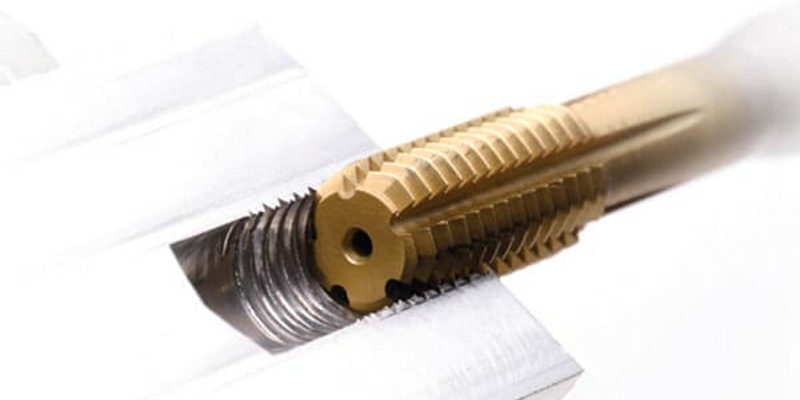- May 21, 2022
Threading is one of the most important machining processes. It is used to create screw threads, which are used to fasten together materials and components.
Threaded holes are very common in manufacturing. Due to versatility and ease of use, they’re so versatile that they can be found in everything from automobiles to aircraft.
But, tapping threaded holes is not as easy as we think. So, it’s important to learn about all the different machined threading technologies available so you can make the best choice for your projects. The following information will help you understand tapping a threaded hole better.
What Is A Threaded Hole?
A threaded hole is a hole that has been threaded or tapped, with internal threads. It is a circular hole used for tapping and drilling processes. For creating threads to the walls of the drilled hole, you can use the tapping process, and it occurs in an area and site where bolts and nuts can not work, such as in metals.
Sometimes threaded holes are also called tapped holes. This type of hole is used when it is necessary to connect two parts together using a fastener such as a screw or a bolt. The threads in the hole provide resistance so that the fastener will not loosen over time and also make it easier to remove the fastener if necessary.
What Is A Tapped Hole?
The tapped hole is a type of hole that is used to create internal threads. It is created by drilling a hole in the material and then using a tap to cut threads into the walls of the hole. Tapped holes are commonly found in metal components that need to be secured together, such as in the case of a nut and bolt.
The tapped hole has many similar aspects to a pilot hole. Both are used to create a thread in a workpiece so that a screw or bolt can be inserted. A key difference between the two is that a tapped hole is already threaded and only needs a tool to create the mating thread, while a pilot hole must first be drilled before it can be tapped.
The Importance Of Creating A Tapped Hole
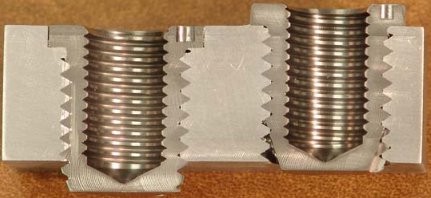
Tapped holes are essential aspects of machine parts, and you can use a CNC machine to add a hole. In the tapping process, you can create threads to the walls of the drilled hole. Machine screw can not create their own threads, If you want to drive a screw into a metal material, you need a tapped hole and make threaded elements add to a CNC machine process.
Each feature will add appropriately to threaded parts, and most threads can choose depending on their features. Let’s us why it is important to create a tapped hole.
1. Connection
If you want to thread a bolt or screw into the metals, it can make it possible to attach two parts with more reliability. Threading can permanently attach a bolt, nut, and screw with a metal.
2. Easy transportation
A tapped hole makes assembling tiny parts and products easy for shipping to reduce labor costs to a great extent.
3. Simple operation
It can provide a place for screw fasteners and tapped holes. You can drive a screw or bolt on metal more easily without making a pilot hole.
You can create threads on the interior side of the drilling hole, and it takes less time than the process of drilling a bolt, a nut, or a screw into wood. Tapping a hole can suit your project’s requirements no matter if you need a through-hole or a blind hole.
How To Make A Hole Before Tapping?
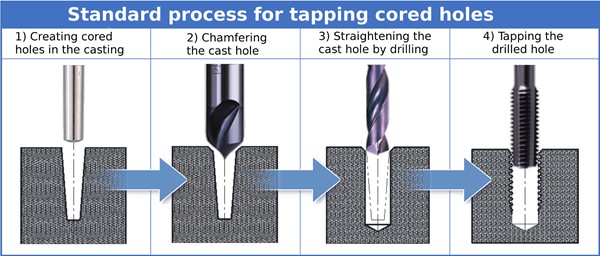
It is essential to have straight, good, and proper size holes for threading in the hole-making process. In-state of art machinery drilling (oversize) factor is mostly removed, but it has great importance in the hole-making process, so it is critical to consider how to make a hole before tapping.
A tapped hole was formed using a tap drill bit and a drill bit. A pilot drill bit can make the initial hole, while a tap drill is mostly used to cut the threads in a tapped hole. After inserting a screw, its outer threads(external threads) can wind down into the internal threads. Internal threads can create a tap a bit in a tapped hole.
Some machinists still use the old rules and standards and tap drill charts for a threaded hole. One example of threads is as they use 17/32 die and tap drill for 5/8-11, these percentages of thread sometimes make work more complicated. Therefore, it is necessary to carefully understand the standard of thread and the use of different tapping tools before tapping the hole.
Before making a threaded hole, you can get various options for pilot drill size and tap drill size, find an expert person who understands tap drill and different thread sizes can make a big difference for your project.
What are blind holes and through holes?
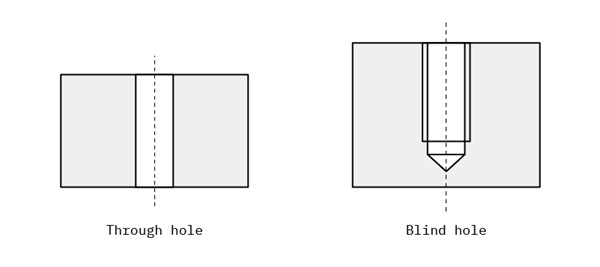
There are two types of holes for the definition of threaded holes. Each type of hole demands specific considerations to make sure threaded holes are easy to machine.
Blind hole: This hole has a certain deepness and can not pass through the whole workpiece. Deepness needs to be fixed separately. The bottom of the hole can end on a flat surface or end in a cone.
Through hole or clearance hole: A hole can go through the entire workpiece in a through-hole. The deepness of a through-hole is the thickness of a particular wall. Using a bolt, a screw, and nuts, you should use a through-hole for easy procedure.
What are the differences between drilling and tapping?
The main difference between drilling and tapping is the sequence and performance of functions and drill bit. This process occurs first to make a round and smooth hole using a drill bit, which is called drilling.
The formation of a tapped hole is completed using a tap drill bit and drill bit in which the pilot drill bit initially forms the hole and then can cut the threads by using a tap drill. Taps can handle most types of materials such as aluminum, steel alloy, steel, and cast iron,
This round and smooth hole are made in this process, while on the other side when a hole is drilled, a process of tapping happens to make threads by applying a tap to the interior of the hole.
Except for these processes, creating threads can accomplish and accommodate the outside of a cylindrical object in a die-cut process by using a die. The threads on a bolt are one example of a die-cut.
Three Types of Taps For Threading
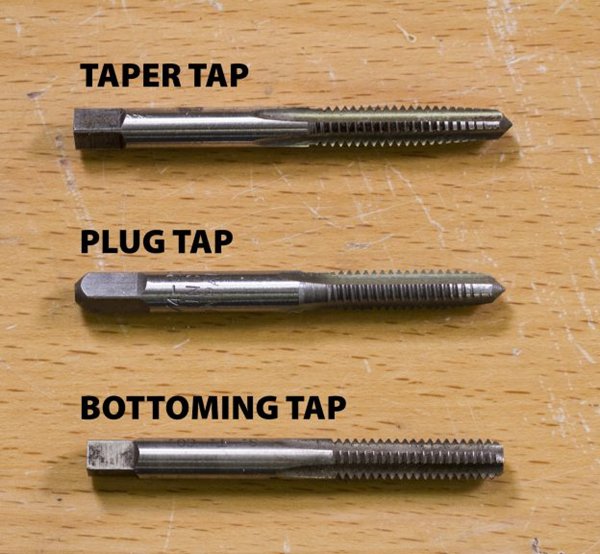
The main types of taps are Plug tap, Taper tap, and Bottom tap.
These types are used and designed to perform a specific function or purpose and can thread specifically around any hole thrown at them.
Taper Taps
A taper tap has a conical tip and a slight angle to the threads, which is also called a chamfer. Usually, the first seven to ten threads aren’t completely formed. The tapered angle of the threads allows the threads to be started much easier than if you started with a bottom tap. This type of tap is generally used for starting a new thread in a hole.
If the hole that needs to be tapped is very large, or if the material is very hard, it is not recommended to use a taper tap. In these cases, it is better to use a spiral point tap instead. Taper taps are also not recommended for blind holes (holes that do not go all the way through the material).
Plug Taps
Plug taps occur between a taper and bottom tap, and due to this reason, it is also called a “second tap.” But plug taps need more force for turning as they cut more threads at one time.
Plug taps are the best example to repair threads that require a little fixing. They are perfect for tapping a hole deeper than taper taps thread.
There are a few instances where it is not recommended to use a plug tap. One example is if the hole being tapped is very close to the edge of the material. This is because the tap can easily break if it hits the edge while in use. Additionally, using a plug tap on a very small diameter hole can be difficult and may result in the tap breaking.
Bottom Tap
The bottom tap is a type of tap that starts from the bottom of the hole. It is used when there is not enough space to start the tap from the top. The bottom tap makes it possible to cut threads all the way to the bottom of a through-hole. This type of tap is also useful for fixing mistakes made while tapping from the top. It is mostly used for:
Threads or threading a shallow blind hole
Deep threads & shallow hole
Tapping a new hole
A bottom tap is a specialized tool and may not be available in all sizes, so it is important to check before beginning a project.
Tips And Considerations For Tapped Holes
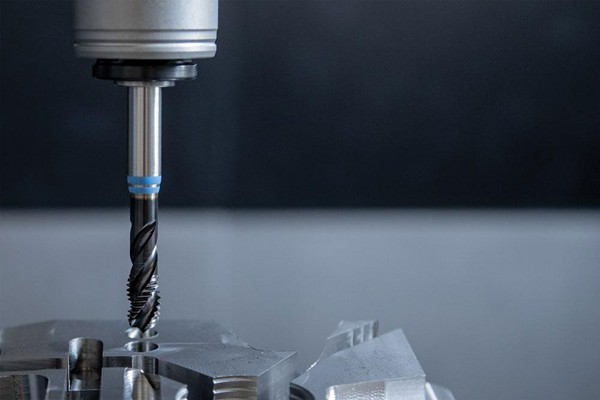
Tapped holes are considered essential to adding mechanical fastened parts with machines. It will be a big damage to the CNC machined parts if you try to add and force a scrap in the wrong way. So, careful considerations and planning before machining a threaded hole is essential and will help you avoid some unnecessary troubles.
1. Methods to make tapped holes: cutting and forming
You can make an internal thread in tapped holes in two ways:
by using a forming tap
by using a cutting tool
Although both these methods give you the same result, you have to consider some factors to choose one of these methods, such as the size of the threaded hole, machine lathes, hardness of the material, and blind or through-hole.
1: Size of the threaded hole- You can use a forming tap or a traditional cutting tap if the threaded hole is up to M6. You can use a single lip tool to cut the threaded hole more than M6. Because needing the larger tap for cutting threaded holes for more machine horsepower.
2: For Hard materials -You can use a cutting tap for hard and sturdy materials for hard materials. The fluting of the cutting tap provides lubricant to flow down a path and gives metal shavings more space to the cutting edge.
3: For a soft material- Use forming taps for non-ferrous soft metal materials such as brass, lead, steel, and aluminum. Forming taps can create internal threads in softer metals without breaking. This is because the cutting action is slower and more controlled, which helps to prevent damage to the material.
2. Use standard threads size if possible
The size of the threads used in CNC machines is of great importance. It greatly affects the whole machining process. You must try to use standard sizes of thread under possible conditions.
There are a few common thread sizes including 1/4-20, 3/8-16, and 1/2-13. Each of these sizes corresponds to a different diameter and pitch, which helps to ensure that the threads will fit properly onto the desired object. Additionally, there are also metric thread sizes. The most common metric sizes are M6 x 1.0, M8 x 1.25, and M10 x 1.5.
The machining process does not require any special machining tool or material when standard thread sizes are used. Moreover, it also helps in reducing the machining lead time and material usage and makes it a cost-effective process.
3. Suitable threaded hole diameter
You must make sure that the threaded hole’s diameter must be within the workpiece or part. The threaded hole’s outer diameter must be larger than the internal diameter. Its means that the internal diameter will be smaller than the outer diameter.
The breakage of the thread may occur through the part’s side if the threaded hole is present close to the edge of a part. The breakage of threading may result in the cutting tool or tap breakage, destroying the surface finish.
4. Consider angled surfaces
It may be tough to machine thread holes into angled surfaces. You can add a threaded hole into an existing angled surface by creating a flat surface by machining pockets. The threaded hole is added from this flat surface.
But, in case no angled surface is present, then firstly, you have to do an addition of the threaded hole to the part before the machining of the angled surface. You must make sure that the depth of the threaded hole must meet the design after adding the angled surface.
5. Types of threaded holes
The threaded holes are divided into two types. Both types of holes required definite considerations during designing the part. It is done to ensure the machining of both threaded holes.
Moreover, it also prevents the interference of threaded holes with other parts. The followings are the main types of threaded holes:
Blind threaded holes
The blind threaded holes do not go completely through a part, but it goes to specific parts. The blind holes stop after reaching the specific deepness. If a threaded hole is created using an endmill, then the hole may end on a flat surface. If the hole does not go completely through the material, you know it is a drilled hole. But, if it is created using a traditional mill, it may end at a cone. If it is required to extend the full thread to the bottom of the blind threaded hole, it is done using a bottoming tap.
Dimensioning of a blind hole
The hole diameter is listed for the specification of the blind hole. It also requires dimension for controlling the depth. The remaining amount of material is identified, or the hole depth is directly specified to control the depth.
Through threaded hole
The through-hole goes completely through a part. The threaded holes are present on both sides of the part or workpiece. The part thickness is determined if the cutting tool or the tap reach cannot thread the entire deep hole.
You must consider the following options if the cutting tool or the tap reach cannot thread the single side of the hole.
Keep on adding threads until allowed by the cutting tool or tap. You must note that there is no thread at a portion of the hole.
Keep adding threads on both sides until allowed by cutting tool or tap. You must note that the threads meeting from both sides may not align.
6. Depth of hole
Deep threaded holes present unique machining challenges compared to shallower threaded holes. The increased depth of the threading creates more contact time between the tool and the workpiece, which generates more heat and requires greater cutting force. These factors increase the risk of tool breakage when machining deep threaded holes. To overcome these challenges, special care must be taken when selecting and using cutting tools, and the machining process must be closely monitored to ensure that tool breakage does not occur.
Conclusion
When it comes to tapping threaded holes, it is important to have a complete understanding of the manufacturing process. This way, you can ensure that the parts you produce are of high quality. While it may seem a little complicated, it is best to consult with experts in threading techniques.
At WayKen, we have two decades of experience in machining. Our team of engineers are well-versed in different machined projects, and we always put our clients first. If you have any questions about tapping or machining threads, feel free to contact us!

